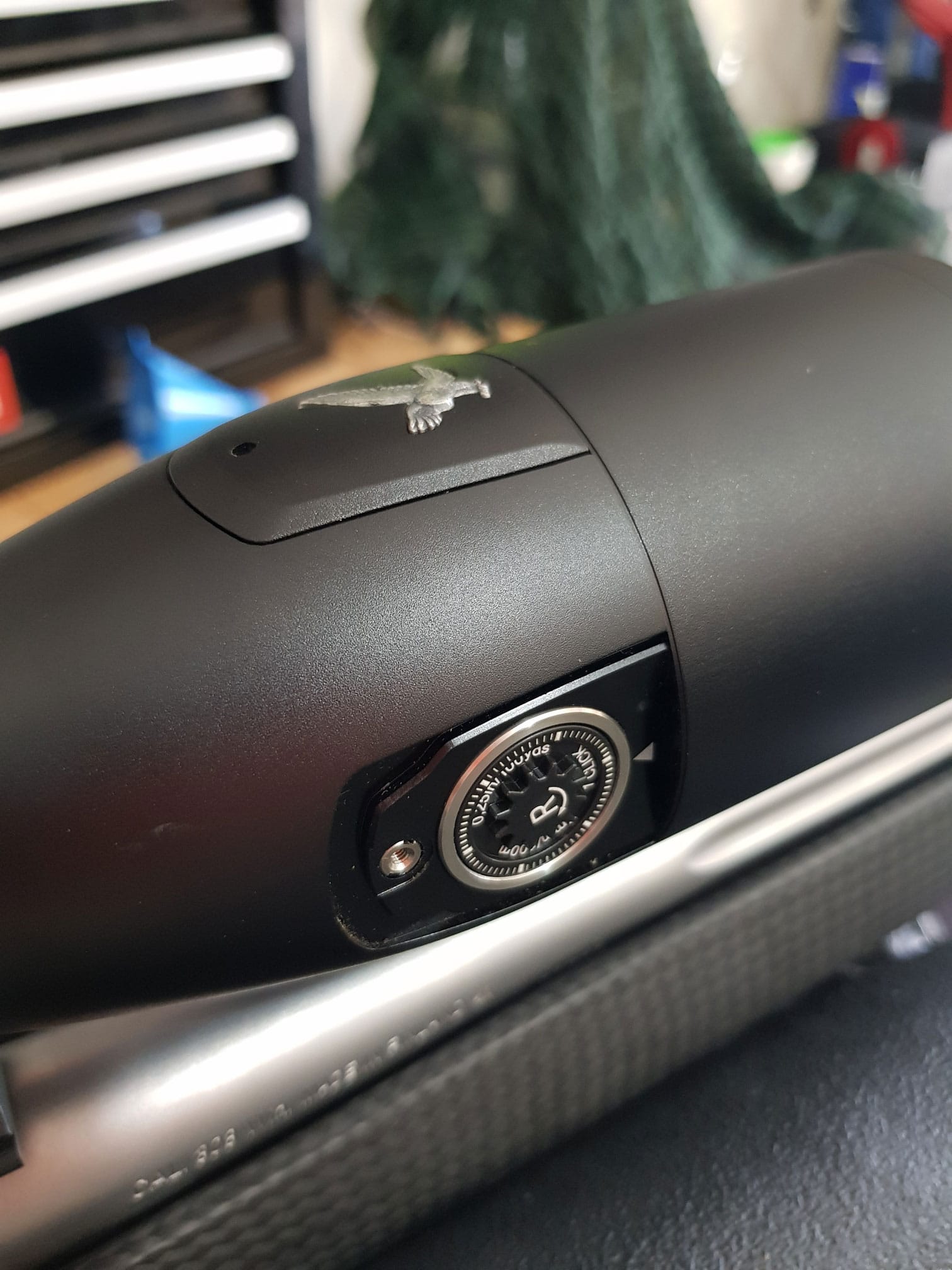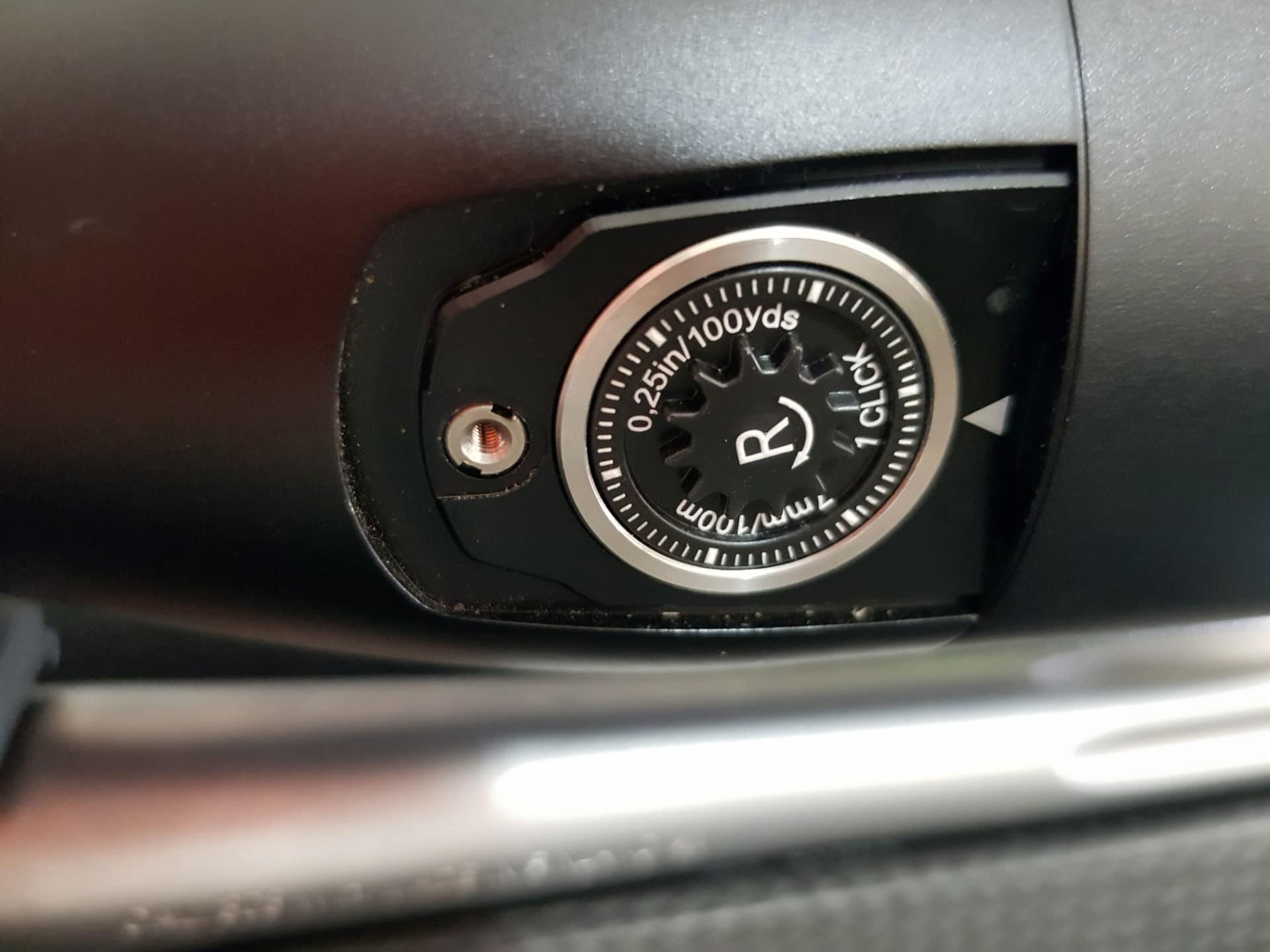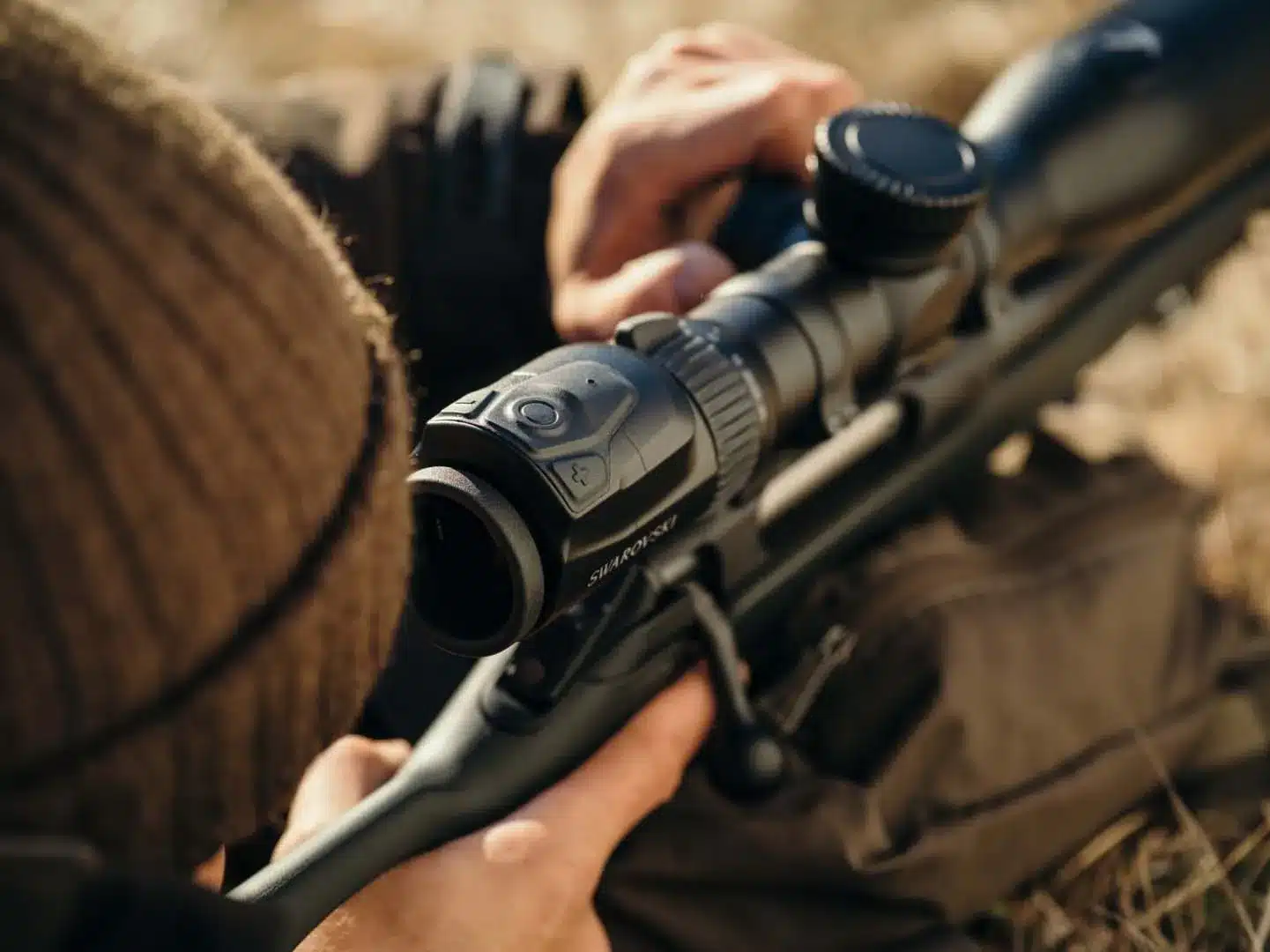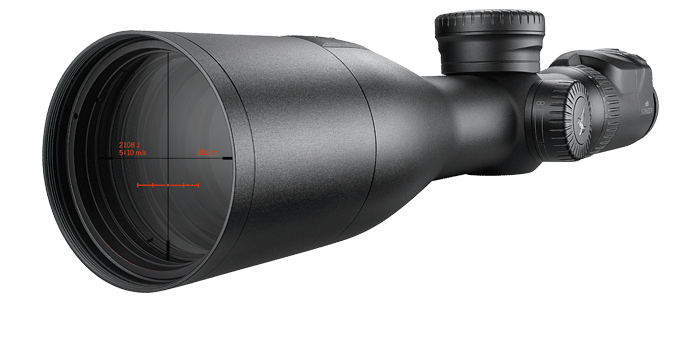Swarovski dS First Impressions
This thing is a beast! A 40mm fat central tube of the Swarovski dS means that it even makes the oversized 34mm scopes I am used to look petite, and, weighing in at just over 1kg (1090 grams) – it’s no featherweight either. To put it into context, the Sako itself weighs around 2.4kg; however, the Vortex Razor HD II 5-25 – my previous tank of a scope, weighs 1.35kg.
However, I think it is a lovely-looking piece of kit, and it certainly exudes a quality you don’t always find on scopes. However, you would also expect that at this price point.
The lack of turrets is initially a little confusing for someone like me, primarily focused on long-range shooting. Sure – many hunting scopes have capped turrets, but this is slightly different.
For a start, if you take off the top cap, where you would expect the turret to be – you are greeted with a battery compartment and a couple of tools to open up the side panels, where the adjustments for the zero can be found.



The concept
Before we talk too much about the setup and details of the scope itself, it’s essential to provide a bit of the concept behind the Swarovski dS.
This is, essentially, a point-and-shoot scope. Line and animal up, push a button on top, the scope ranges the target and instantly returns a point of aim within the reticle, including wind holds.
It does this (in theory) out to 1375 meters. I mean. What doesn’t sound good about that?
For people wanting to stretch out the legs of their firearm further but want to combine the scope, rangefinder and ballistic computer into a scope optic with phenomenal glass and a zoom range of 5-25.
Zeroing and Setup
Don't worry - there is plenty more to read. Gain instant access.
Zeroing the rifle was simple. I took the caps off, read which way to adjust (opposite to many scopes), bore sighted, on paper, adjusted, and confirmed – good to go! As it should, the adjustments on the scope do what they should.
Eye Relief seems short. Like, it’s short. Because of the tube size (40mm), you are limited in your ring choice. This could mean you can’t set it up with the correct eye relief on some rifles. I would suggest you test before you buy. Some Swaro’s (like my Z3) can be notorious for encouraging scope bite, so I would always be a bit wary on a big rifle – though proper form should prevent that.
The next part was a little trickier.
Essentially, a ballistic calculator is built into the scope, which needs to be set up via an application on your smartphone. I downloaded it to my Samsung and quickly loaded the box BC, velocity and details.
You can customise the reticle in the Swarovski dS a fair bit, including thickness, size of aiming dots, windage indicators, and more. It is quite a nice setup.
The Bluetooth connection required the phone to be held while touching the scope to register nearly; however, the transfer to the scope itself worked fast enough. With the ballistics loaded into the rifle, I turned from the 100m zero target to the steel out to 700m.
300m, 450m, no issues. 700, slightly low, which isn’t unsurprising. Often, I find the ammo box velocities are higher than what you get out of a rifle – the target barrel they used might have been longer. The actual velocity must be confirmed over a chronograph or, even better, at the distance.
As it was, I had the Labradar with me, so I had already entered a ‘true’ velocity. Still, even then, it’s not uncommon to need to true the ballistic calculator.
Truing the Ballistics
This was a little bit of a challenge.
While the Swarovski App does provide a mechanism to true the calculator, it requires you being able to take two velocity measurements. Now, the Labradar can do this, but I still question if a maximum distance of 100 meters (usually, the Labradar won’t track that far) – is far enough to provide worthwhile data regarding velocity and, more importantly, BC.
Instead, I would typically use the Kestrel/Applied Ballistics method of entering an actual drop at a far distance (like 700 meters) and the system back calculating it that way.
I am not sure if it’s simply Swarovski’s Euro-centric thinking, or, more so, assuming the end user isn’t likely to true the system at all – but – because there are no dials and no entry into the app, apart from the arbitrary changing figure – basically, you have to change a number, take a shot, hope it was closer, change again, and so on. In the end, close enough became as close as we would get.
Which was, incidentally, perfectly fine to shoot out to 700 meters. Realistically, at that distance, with factory ammunition, 700 meters was about the limit, and while there were misses at that distance, it wasn’t necessarily the scope’s fault. More, error budget and, bluntly, my shooting coming into play.
But yes, in short, the ballistics function works. From what I imagine, the realistic distances this would be used at will do the job nicely.
Optical Performance
Well. It’s a Swaro, so it’s phenomenal. It’s clear, sharp, and virtually free from any chromatic aberration (to my eye, at least).
However, despite the large tube, the Swarovski dS has a relatively narrow field of view, lower than you would expect light transmission, and, interestingly, a relatively narrow depth of field with the parallax. I think a lot of this is due to a big whack of the tube being replaced with electronics, i.e. the rangefinder.
And – here is a pinch – because of this narrow field of view, in conjunction with essentially using hold-over for each shot – I found that once you got past around 700 meters (.308 Hornady Match Factory Ammo) – you couldn’t use the scope at anything more than 15x magnification. The aiming dot ends up below the bottom of the scope and changes to a helpful little arrow instead.
I know you don’t need more than 15x to shoot out to distance. Though, logically, the further you range, the less you can zoom in.
However, you will not look through this scope and think it’s anything but great glass.
It will probably not be my first choice for hunting late into the twilight, though. I didn’t try it. It’s a client’s rifle, not mine, and not a ‘review’ item either, so I am limited on the situations I can put it through.
Who’s it for?
The Swarovski dS is for someone who hunts in tweed. 😉
Well, for a start, let’s be blunt. You need to have the money to get into this kind of scope. It’s not a scope I would be stretching my neck out for, meaning, if you have a budget, this isn’t in it.
Secondly, I would suggest it’s also for someone who either is relatively new to shooting or doesn’t have the time inclination to do much shooting. I don’t negatively mean this; what I mean is they are looking for a solution that will do most of the work for them. Those who want to get deeper into the ballistics and ‘art’ of shooting will likely want something more manual.
This could be an excellent option for guides – as it removes a lot of potential confusion with a client. Put the red dot on the animal and press the trigger.
However, it could also lead to confusion in setup, so we would have to be careful about that. If it’s set up wrong, I could imagine longer shots would lead to frustration.
In short – would I have one? Well… no – I don’t shoot this way so that it wouldn’t make sense to me. However, I do love the Swarovskis for hunting scopes. Instead, I would go with the phenomenal Z5 (hunting only) or X5i (crossover hunting/target) and one of their equally great EL Range Binos. I am also lusting after one of the STR-80 Spotting Scopes with reticle. But this is because of my particular use case.1
I spend as much time behind (actually more) a spotting scope than a rifle at the moment, so being able to spot and range for others becomes a priority. If you are running solo, I can see the Swarovski dS fitting quite nicely into a shooting system.
How about the Burris Eliminator or the new Sig?
Now, the ‘elephant in the room’ we must also discuss is the Burris Eliminator. This is now up to its 3rd generation and, to be fair was likely one of the first of this total solution style scope. And man, did it get some stick when it first came out.
I have to wonder, ironically, if now, that Swarovski, Sig and many other companies have optics with electronics in them, that people will start to realise that the Burris was really just way ahead of it’s time.
Now, the Swarovski DS is, simply put, a much better unit – higher quality glass, a more refined system, and a much higher price. So, you would expect it. I mean, it’s near twice the price. However, they are functionally very similar.
The Sig BDX System is similar, but it still requires a separate rangefinder.
I find it funny that companies are talking about their new scopes as the ‘future of optics’ – credit where credit is due; then, the Burris was way ahead of you all.
I have had it pointed out that Burris wasn’t the first to bring out a rangefinder in scope. Swarovski had the 3-12×50 LRS a while before the Eliminator was released, and Zeiss and Nikon also had something similar. However, for an integrated ballistic solution, it is an all-in-one, point-and-shoot solution. I think so.
Which ultimately, I refer everything back to, because discussing equipment without an idea of what/how you are going to use it is kinda abstract ↩





